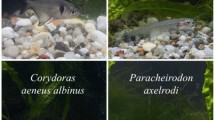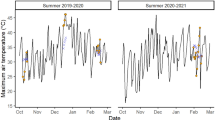Abstract
THE phenomenon of behavioural fever, manifested as an increase in preferred temperature following injection of live or killed bacteria, or other pyrogenic substances, has been demonstrated in bony fishes1–3, amphibians4,5, reptiles5–10, and mammals11,12. Ectothermic vertebrates, including some newborn mammals11, are unable to increase their body temperatures much above ambient by physiological means, and so are largely limited to behavioural thermoregulation by selecting favourable temperatures in their environment. The behavioural febrile response of a lizard, Dipsosaurus dorsalis, has been shown to have adaptive value5,8–10 in conferring increased survival during infection by the Gram-negative bacterium Aeromonas hydrophila. A. hydrophila is pathogenic to bony fishes, amphibians and reptiles, causing haemorrhagic septicaemia. All three classes show similar (1–5 °C) elevations in preferred temperature in response to injection of this bacterium1–10. The absolute preferred temperatures, however, both normal and febrile, differ considerably among these vertebrates. The preferred temperatures of lizards such as D. dorsalis (about 40 °C) are quickly lethal to most fishes and amphibians. We report here that fever significantly enhances survival of goldfish, Carassius auratus, at febrile temperatures about 10 °C lower than those of D. dorsails, after injection with live A. hydrophila.
This is a preview of subscription content, access via your institution
Access options
Subscribe to this journal
Receive 51 print issues and online access
$199.00 per year
only $3.90 per issue
Buy this article
- Purchase on SpringerLink
- Instant access to full article PDF
Prices may be subject to local taxes which are calculated during checkout
Similar content being viewed by others
References
Reynolds, W. W., Casterlin, M. E. & Covert, J. B. Nature 259, 41–42 (1976).
Reynolds, W. W. & Covert, J. B. in Drugs, Biogenic Amines and Body Temperature (Karger, Basle, in the press).
Reynolds, W. W. Comp. Biochem. Physiol. (in the press).
Casterlin, M. E. & Reynolds, W. W. Life Sci. 20, 593–596 (1977).
Kluger, M. J., Bernheim, H. A., Vaughn, L. K., Foster, M. A. & D'Alecy, L. G. in Drugs, Biogenic Amines and Body Temperature (Karger, Basle, in the press).
Bernheim, H. A., Vaughn, L. K. & Kluger, M. J. Fedn. Proc. 33, 457 (1974).
Vaughn, L. K., Bernheim, H. A. & Kluger, M. J. Nature, 252, 473–474 (1974).
Kluger, M. J., Ringler, D. H. & Anver, M. R. Science 188, 166–168 (1975).
Kluger, M. J. Nat. Hist. 85, 70–75 (1976).
Bernheim, H. A. & Kluger, M. J. Science 193, 237–239 (1976); Am. J. Physiol. 231, 198–203 (1976); J. Physiol. (in the press).
Satinoff, E., McEwen, G. N. Jr & Williams, B. A. Science 193, 1139–1140 (1976).
Crawshaw, L. I. & Stitt, J. T. J. Physiol. 244, 197–206 (1975).
Reynolds, W. W., McCauley, R. W., Casterlin, M. E. & Crawshaw, L. I. Comp. Biochem. Physiol. 54A, 461–463 (1976).
Reynolds, W. W. J. Fish. Res. Bd Can. 34, 300–304 (1977).
Reynolds, W. W. & Casterlin, M. E. Thermal Ecology II (eds Esch, G. W. & McFarlane, R. W.), 185–190 (ERDA Symp. Ser CONF-750425, US Natl Tech. Info. Serv., Springfield, Virginia, 1976).
Fry, F. E. J. Univ. Toronto Stud., Biol. Ser. 55 (1947).
Ferguson, R. G. J. Fish. Res. Bd Can. 15, 607–624 (1958).
Avtalion, R. R., Wojdani, A., Malik, Z., Shahrabani, R. & Duczyminer, M. Curr. Top. microbiol. Immunol. 61, 1–35 (1973).
Hildemann, W. H. Am. Natur. 96, 195–204 (1962).
Amend, D. F. J. Fish. Res. Bd Can. 27, 265–270 (1970); 33, 1059–1066 (1976).
Peterson, R. H. J. Fish. Res. Bd Can. 33, 1722–1730 (1976).
Author information
Authors and Affiliations
Rights and permissions
About this article
Cite this article
COVERT, J., REYNOLDS, W. Survival value of fever in fish. Nature 267, 43–45 (1977). https://doi.org/10.1038/267043a0
Received:
Accepted:
Issue Date:
DOI: https://doi.org/10.1038/267043a0




